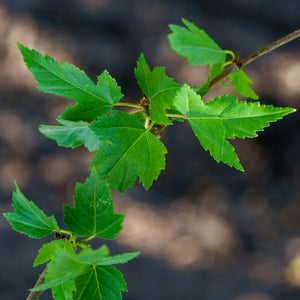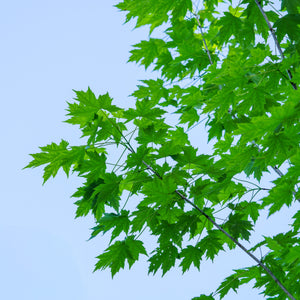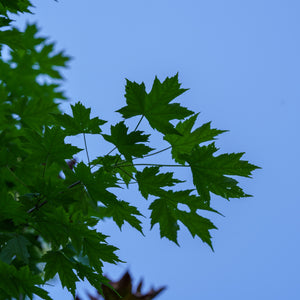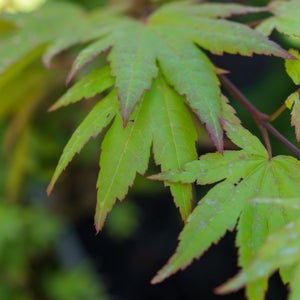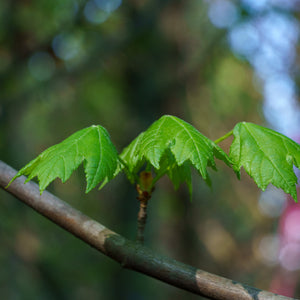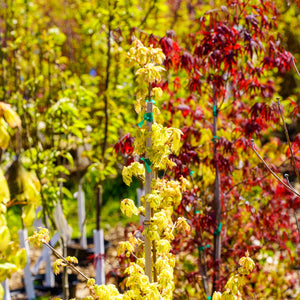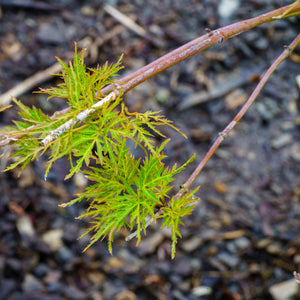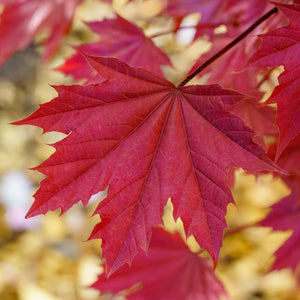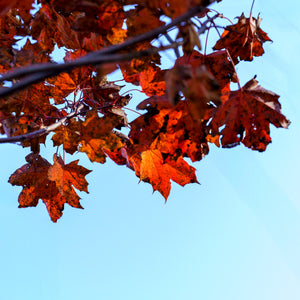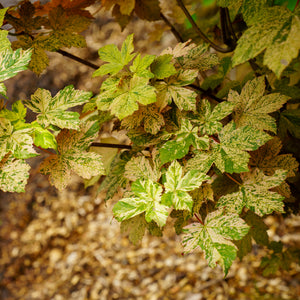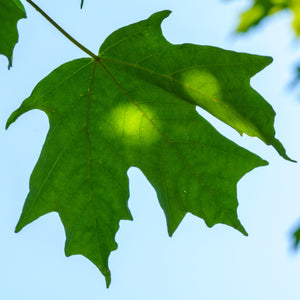The Maple Guide
Maple trees bring a majestic and enduring presence to any landscape. With their tall and graceful stature, distinctive bark, and vibrant foliage, maple trees captivate the eye and infuse gardens and outdoor spaces with a sense of grandeur. These remarkable trees are celebrated for their versatility and ability to thrive in diverse environments when provided with adequate care and attention. Whether you envision a serene woodland sanctuary or a captivating centerpiece for your garden, maple trees are a superb choice that will undoubtedly leave a lasting impression.
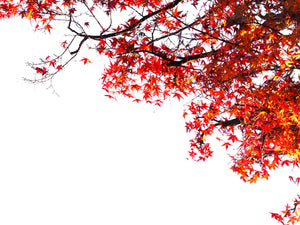
About
Maple trees, belonging to the Acer genus, encompass a diverse group of deciduous trees renowned for their remarkable presence and ecological significance. With numerous recognized species, maple trees are found throughout the temperate regions of the Northern Hemisphere, including North America, Europe, and Asia. These magnificent trees are characterized by their distinct features and vital role in supporting local ecosystems.
One of the defining characteristics of maple trees is their striking bark, which varies in color and texture, adding visual interest to their overall appearance. The leaves of maple trees are typically palmate, with lobes radiating from a central point, showcasing a rich spectrum of green hues during the growing season. As autumn approaches, maple trees undergo a breathtaking transformation, presenting a splendid array of vibrant colors, including shades of red, orange, and gold.
Maple trees hold great ecological importance, providing food and shelter for a wide range of wildlife. Their flowers, arranged in clusters known as inflorescences, appear in spring and serve as a valuable source of nectar for bees and other pollinators. The seeds of maple trees, known as samaras or "helicopters," are dispersed by the wind and serve as a nutritious food source for various birds and small mammals.
These versatile trees exhibit adaptability to different soil types and environmental conditions. While they prefer well-drained soil, maple trees can thrive in a range of sun exposures, from full sun to partial shade. Their ability to withstand diverse climatic conditions and their moderate to fast growth rate make them a popular choice for landscaping projects.
Whether utilized as a striking focal point in a garden, planted in groups to create a vibrant display, or incorporated into mixed borders, maple trees impart a sense of elegance and natural beauty to any landscape. Popular species of maple trees include the Sugar Maple (Acer saccharum), known for its stunning fall foliage and sap used in maple syrup production.
By carefully selecting and nurturing maple trees in your landscape, you not only enhance the aesthetic appeal of your outdoor space but also contribute to the preservation of these remarkable trees and the diverse ecosystems they support.
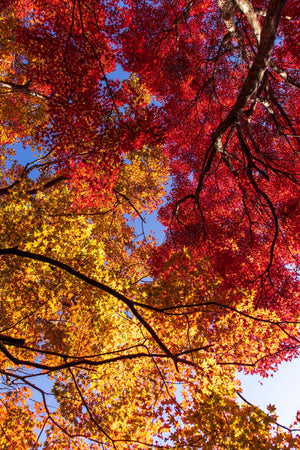
Planting
Maple trees have specific planting requirements to ensure their successful establishment and growth. Here are some general guidelines for planting and caring for maple trees:
Soil: Maple trees thrive in well-drained soil that is rich in organic matter. They prefer a slightly acidic soil with a pH between 6.0 and 7.0. Prior to planting, prepare the site by loosening the soil and incorporating compost or organic matter to improve drainage and enhance soil fertility.
Sunlight: Maple trees prefer full sun to partial shade. Choose a location that receives at least six hours of direct sunlight each day. However, they can tolerate some shade, especially in regions with hot and dry climates.
Watering: Adequate watering is crucial for the initial establishment of maple trees. After planting, water the tree deeply and thoroughly. Provide regular irrigation throughout the first year to ensure the roots have sufficient moisture. Water deeply once or twice a week, adjusting the frequency based on rainfall and soil moisture levels. Avoid overwatering, as it can lead to root rot.
Mulching: Apply a layer of organic mulch around the base of your maple tree to conserve moisture, suppress weed growth, and regulate soil temperature. Use wood chips, bark, or compost as mulch, making sure to keep it a few inches away from the trunk to prevent excess moisture buildup and potential disease issues.
Pruning: Maple trees generally require minimal pruning. Remove any dead, damaged, or crossing branches to maintain a strong and balanced structure. Prune during late winter or early spring while the tree is still dormant, before new growth emerges. Use clean and sharp pruning tools to minimize the risk of infections.
By following these basic planting and care guidelines, you can ensure the successful establishment and healthy growth of your maple trees. With proper care, your maple trees will flourish and bring beauty and shade to your landscape for years to come.
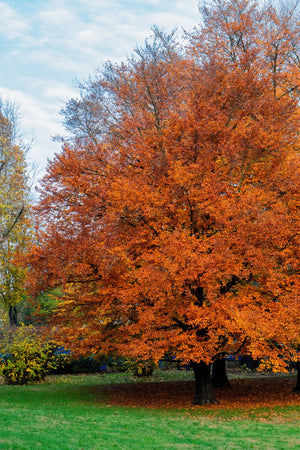
Care
Maple trees require specific care to ensure their optimal growth and health. Here are some general guidelines for the care of maple trees:
Watering: During the growing season, provide moderate watering to your maple trees. Aim for about one inch of water per week, adjusting as needed based on rainfall. It's important to water deeply and thoroughly to promote deep root growth. Avoid shallow watering, which can lead to stress and dehydration. In periods of drought or high temperatures, additional watering may be necessary to keep the soil adequately moist.
Pruning: Maple trees typically do not require extensive pruning. However, it's advisable to remove any dead or damaged branches to maintain the tree's overall health and appearance. You may also shape the tree to achieve the desired size and form. Prune during late winter or early spring before new growth emerges. Use clean, sharp pruning tools to minimize the risk of damaging the tree. Deadheading spent flowers can also encourage new growth and potentially trigger a second blooming.
Fertilizing: Fertilizing can promote healthy growth and vigor in maple trees. Apply a balanced, slow-release fertilizer in the spring or early summer, following the recommended application rates and timing provided by the manufacturer. Avoid over-fertilizing, as it can lead to excessive foliage growth and weak branches. It's best to follow a conservative approach and use less fertilizer if unsure.
Soil and Sunlight: Maple trees thrive in well-drained soil that is rich in organic matter. They can adapt to various soil types, but ensuring good drainage is crucial for their optimal growth. Provide full sun to partial shade for maple trees, with at least six hours of direct sunlight each day. Partial shade can be beneficial in hotter regions to protect the tree from excessive heat.
Mulching: Apply a layer of organic mulch around the base of your maple tree to conserve moisture, suppress weed growth, and regulate soil temperature. Use wood chips, bark, or compost as mulch, keeping it a few inches away from the trunk to prevent moisture accumulation and potential rotting.
Pests and Diseases: While maple trees are generally resistant to pests and diseases, it's important to monitor for common issues such as aphids, scale insects, or fungal diseases like leaf spot. Regularly inspect your tree for any signs of damage or disease and take appropriate measures if needed. Pruning away infected branches and maintaining overall tree health can help prevent and manage pest and disease issues.
By following these basic care guidelines, your maple trees will thrive, providing beauty, shade, and a captivating presence in your garden for years to come.
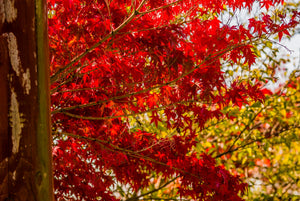
How To Use
Maple trees offer versatility and can be used in various ways to enhance your landscape. Here are some recommendations based on their characteristics:
Focal Point: Maple trees make an excellent focal point in your landscape due to their stunning foliage and graceful form. Plant a single maple tree in a prominent location to draw attention and create a captivating centerpiece for your garden.
Shade Tree: With their wide-spreading canopies, maple trees provide ample shade. Plant them strategically near outdoor seating areas, patios, or decks to create a cool and comfortable space where you can relax and enjoy the outdoors.
Colorful Display: Maple trees are renowned for their vibrant foliage, particularly in the fall. Take advantage of their stunning colors by planting them in areas where their autumn display can be fully appreciated, such as along pathways or as a backdrop for other plants.
Maple Syrup Production: Certain varieties of maple trees, such as the sugar maple (Acer saccharum), are highly valued for their sap, which is used to make maple syrup. If you're interested in producing your own maple syrup, select sugar maple trees or other syrup-producing maple species. Tap the trees in late winter or early spring when the sap begins to flow, and collect the sap to boil it down into delicious maple syrup. This process can be a rewarding and tasty way to make use of maple trees in your landscape.
Windbreak: Maple trees can serve as a natural windbreak, thanks to their dense foliage and sturdy growth. Plant them in a row to create a windbreak that shields your garden, home, or outdoor living spaces from strong winds.
Privacy Screen: Utilize the dense foliage of maple trees to create a natural privacy screen in your landscape. Plant them in a row along your property line to establish an attractive and effective barrier that enhances privacy and adds visual appeal.
Wildlife Habitat: Maple trees attract various wildlife species, including birds and squirrels, who seek shelter and food from their seeds and branches. By planting maple trees, you can create a thriving habitat that supports local wildlife and brings your garden to life with their presence.
When selecting maple trees for your landscape, consider their growth rate and environmental requirements. Ensure they are planted in areas that receive full sun or partial shade, and provide well-drained soil. With their majestic beauty and functional benefits, maple trees are a fantastic addition that will enhance the aesthetics and liveliness of your outdoor environment.
Conclusion
Maple trees are a captivating and versatile addition to any landscape. With their stunning foliage, graceful form, and cultural significance, maple trees are highly valued for their beauty and numerous practical uses. By following proper planting and care practices, you can harness the full potential of maple trees to enhance your outdoor space and create a lasting impact. Whether you seek a striking focal point or a shaded retreat, maple trees can fulfill various roles in your landscape. Plant a single maple tree in an open area to showcase its grandeur and vibrant foliage, or group multiple maple trees together for a dramatic effect. Maple trees provide excellent shade, making them ideal for planting near outdoor seating areas, patios, or decks, creating a cool and comfortable space. Certain varieties of maple trees, such as the sugar maple, offer additional benefits, as they can be tapped to collect sap and make delicious maple syrup. With their beauty, functionality, and the possibility of producing your own maple syrup, maple trees bring joy and a touch of sweetness to your outdoor environment.

